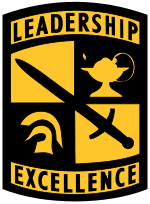Army ROTC
| Army ROTC | |
|---|---|
 |
|
| Active | 1916–present |
| Branch | United States Army |
| Role | Officer Training |
| Garrison/HQ | Fort Knox, Kentucky |
| Motto(s) | "Leadership Excellence" |
| Website | ROTC Website |
The Army Reserve Officers' Training Corps (ROTC, AROTC, or SROTC) is the United States Army component of the Reserve Officers' Training Corps. It is the largest ROTC program, with 20,000 ROTC cadets in 273 ROTC programs at major universities throughout the United States.
The modern Army Reserve Officers' Training Corps was created by the National Defense Act of 1916. This program commissioned its first class of lieutenants in 1920. The concept behind ROTC, however, had its roots in military training which began taking place in civilian colleges and universities as early as 1819 with the founding of the American Literary, Scientific and Military Academy at Norwich, Vermont, followed by various state chartered military schools, and finally civilian land grant colleges after the Civil War, which required military training.
For a cadet who takes only the first two years of ROTC (Basic Course), there is no military obligation, unless the student is a 3-4 year scholarship cadet or has other specific scholarships. If a cadet has accepted a scholarship, service commitments may vary. With some exceptions, in order to progress to the last two years of the program (Advanced Course), the cadet must contract with the United States Army. To do so, the student enlists in the United States Army Reserve Control Group (ROTC) as a cadet and elects to serve on either active duty or in a reserve component (Army National Guard or Army Reserve).
The following is an outline of a general military science program.
Basic Course Qualification Requirements
A candidate for freshman and sophomore level ROTC training must:
A student who does not meet all of the above requirements should consult with the Department of Military Science and Leadership to determine if waivers can be granted.
Military Science I year (MSI)
This year serves as the cadets' first introduction to the Army. Topics covered include military courtesy, military history, basic first aid, basic rifle marksmanship, basic hand grenade use, land navigation, rappelling, fundamentals of leadership, map orienteering, field training, and drill and ceremony.
Military Science II year (MSII)
...
Wikipedia
